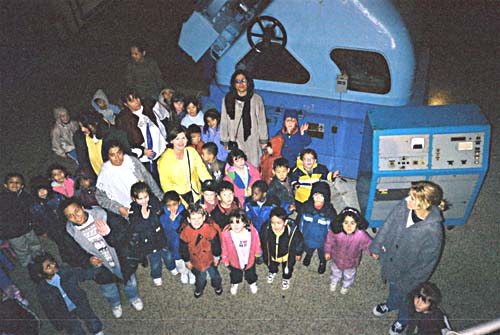
University of Toronto Astronomy Outreach Programs
Volume 34, Number 1
October 6th, 2003



We, the editors, apologize for the hiatus in publication of the DOINGS. However, if Saturday Night magazine can bounce back after missing 11 issues, so can we! After all, it has not been as much as a year since The DOINGS was last published. In fact, it has only been 10 months, though I must admit that it seems longer to me. The problem is the usual: the Editor- in-Chief (rG) is retired and busier than ever doing the things that retired astronomers do (observing, reducing data, the occasional lecture...); the Managing Editor (IKS) is up to his ears in Outreach programs and Public Tours; and the Associate Editor for student affairs is trying to finish a thesis. The latter two will be moving on to bigger and better positions soon (we hope), so I would like to have some help producing the next issue. Any volunteers?
The DOINGS plays the important role of providing a link among the dispersed elements of the department. For the link to be effective, more people need to be involved and to contribute information about their activities and interests. So, if you are doing something interesting, let us know. Let's expand the DOINGS as the department grows in size and stature.
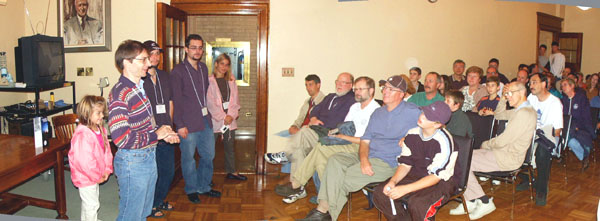
With Astronomy now a formal (though still not mandatory) part of the Ontario school curriculum, professional astronomers have an excellent opportunity to promote their particular area of research and build future public support for new science initiatives by assisting teachers in delivering quality science education to their students. And based on the demand experienced this past summer for a glimpse of Mars through even a small telescope, the general public is also eager to learn more about astronomy. This comes at a time when the number of venues available for casually learning about astronomy within the Greater Toronto Area is steadily declining (e.g.- none of Toronto's fixed-seating planetariums are currently open to the public).
Public education has always been and continues to be a long-standing tradition at the David Dunlap Observatory. Indeed, the Observatory owes its very existence to the efforts of the University of Torontoís first astronomer, Dr. C. A. Chant, who lectured publicly for many years before catching the ear of the Dunlaps. David Dunlap was a lawyer and amateur astronomer inspired by Chantís orations and through the actions of his wife Jessie, allowed Chant to realize his dream of a large telescope for eastern Canada.
Following the completion of the 74-inch telescope and the retirement of Dr. Chant, a new voice rose up among the ranks of the Observatoryís newly hired: Dr. Helen Saywer Hogg spent sixty years of her life tirelessly educating the public about astronomical research and the beauty of the nighttime sky. She wrote a regular newspaper column, numerous books and availed herself to anyone curious about the operation of the Observatory or about astronomy in general.
During the past year, concurrent with my undergraduate teaching responsibilities at the University of Toronto, I have had the pleasure of helping continue the tradition of Public Outreach at the David Dunlap Observatory. From May through to October, I have been managing the "Summer Evening Tours" program where graduate students and astronomers provide the general public with weekly talks and a chance to view celestial objects directly with their own eyes using the 74-inch telescope.
Itís a rarity for the general public to be invited to make observations at a large professional telescope. Time consumed by the public at the DDO 74-≠inch telescope comes at the expense of professional astronomers who graciously give up some of their precious telescope time. Some of these astronomers come from as far away as eastern Europe to use nights theyíve been assigned months in advance.
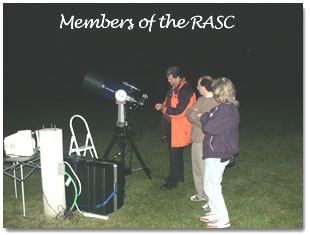 In addition to the view through the 74-inch, the public also has the opportunity to view through smaller telescopes provided and manned by members of the Royal Astronomical Society of Canada (Toronto Center). This voluntary contribution is very much appreciated as it greatly enriches the experience for our visitors.
In addition to the view through the 74-inch, the public also has the opportunity to view through smaller telescopes provided and manned by members of the Royal Astronomical Society of Canada (Toronto Center). This voluntary contribution is very much appreciated as it greatly enriches the experience for our visitors.
During last yearís Summer Evening Tours, we gave lectures and a view through the 74-inch telescope to over 1600 people. This year, we accommodated over 2100 people during a total of 57 tours given on 26 different nights. These numbers take into account the two nights (4 tours) lost due to the local power-outage on August 8th and the massive blackout one week later on August 14th. The heightened public interest due to Mars being at its historical closest this past August easily made up for the poor attendance at the beginning of the season due to SARS.
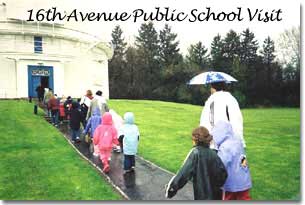 When the Summer Tours program comes to an end, lectures and tours continue from October through to June at the rate of up to four per week provided to Schools and Scouting/Guiding groups. Last year, I personally spoke to over 700 students in grades ranging from Kindergarten through to High School and beyond.
When the Summer Tours program comes to an end, lectures and tours continue from October through to June at the rate of up to four per week provided to Schools and Scouting/Guiding groups. Last year, I personally spoke to over 700 students in grades ranging from Kindergarten through to High School and beyond.
I follow in the footsteps of many who have come before me, continuing the tradition of Public Outreach that is as old as the Observatory itself. We receive several letters a year from people recalling their visit to the Observatory made many years ago. This past year, I received a letter from a gentleman who came with his school group back in 1935, the year the telescope first went into operation.
Providing the public with access to our facility and to the astronomers that work here is an important step towards gaining and maintaining public support for the work that we do. Iím glad to be part of this effort and hope others will continue this fine tradition at the DDO.
| (Supervisor) | |
| Jordan Ang | ( Y. Wu ) |
| Andrew Calzavara | ( C. Matzner ) |
| Jennifer Golding | ( H. Yee ) |
| Hans Hamm | ( C. Matzner ) |
| Sarah Janes | ( C. Clement ) |
I am pleased to announce that Bob Garrison has been awarded "The Queen's
Golden Jubilee Medal." The Commemorative Medal for the Golden Jubilee
of Her Majesty Queen Elizabeth II is part of the Canadian Honours System
established in 1967. You can see a rendition of this splendid medal on
the web page of the Governor General
http://www.gg.ca/honours/golden-jubilee_e.asp.
"The Medal will be awarded to Canadians who have made a significant
contribution to their fellow citizens, their community or to Canada."
From these criteria we can readily see why Bob Garrison was chosen for
this honour. Congratulations Bob!
"The awarding of the medals will focus both on the achievements of those
people who, over the past 50 years, have helped create the Canada of
today, and on the achievements of younger Canadians who are actively
contributing to our future."
It is a banner year. Tenure and promotion to Associate Professor
(effective 1 July 2003) have been awarded to Bob Abraham,
Barth Netterfield, and Ue-Li Pen.
Congratulations to them on this achievement!!!
I am pleased to announce that Tracy Webb has been awarded the RASC/CASCA
J.S. Plaskett Medal for her recent thesis. The award, consisting of
a gold medal, is made annually to the Ph.D. graduate from a Canadian
university who is judged to have submitted the most outstanding doctoral
thesis in astronomy or astrophysics in the preceding two calendar years.
Tracy has been invited to receive her award and to present a lecture at
the CASCA meeting in Waterloo in early June. Congratulations Tracy!
and
I am pleased to announce Allen Attard as the winner of the Fieldus Award
for 2003. Allen has been outstanding in the many aspects for which the
award is given: academics, teaching, service to the astro community, and
outreach. More will of course be said at the Department celebration
where we present the award, but in the meantime: Congratulations Allen
on this well-deserved award!
I know you will be pleased to learn that Heather Cameron has been
awarded a Canada Graduate Fellowship by NSERC. This is one of the new
group of prestigious awards - only 16 were awarded to U of T. It carries
a value of $35,000 p.a. and is renewable for up to two years.
Please join me in congratulating Heather - this is great recognition.
GASA welcomes this year's new students: Marija Stankovic, Fernando Pena, Hilding Neilson, and Hans Hamm. We'd also like to express our congratulations, cheerful smiles, and best wishes to older students Rob Reid, Wayne Barkhouse, Pengjie Zhang, and Rosemary McNaughton, who have left the department more or less recently to go on to new jobs outside Toronto. Congratulations also to Rosemary and Gary on their wedding, and to Lihong on the birth of her baby girl.
Well, another year has come and gone, and a new set of GASA postions has been elected. The results of the elections are:
| Pres: | Paula (Ehlers) |
| Secretary: | Carrie (Bridge) |
| Treasurer: | Adam (Muzzin) |
| Friend of the Editor: | Hilding (Neilson) |
| Juice: | Kris (Blindert) |
| Newspaper: | Ting Ting (Lu) |
| Coffee: | Kris (Blindert) |
| Colloquium: | Brian (Lee) |
| Computer Rep: | Tornado (Li) |
| Sun Angles: | John (Liska), Hans (Hamm) |
| Hiring Com: | Lawrence (Mudryk) |
| Desks: | Fernado (Pena) |
| Health & safety: | Megan (McClure), Jenna (O'Neill) |
| Tea: | Marija (Stankovic) |
| Web com: | Lawrence (Mudryk) |
| Plants: | Marija (Stankovic) |
| Public Night Organizer: | Tornado (Lee) |
| Mini Courses: | Jenna (O'Neill) |
| Union Steward: | Paula (Ehlers) |
Thanks to everyone who volunteered or was coerced into a position. Also thanks to Preethi for her outstanding job as last year's GASA President.
OK, that's all the news I can think of for now, although I'll add a reminder to submit your entries to the Droppings & contribute to our annual collection of comic relief. See you all at the Countdown!
HANS HAMM
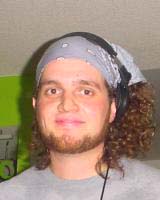 The first couple of decades of my life focused on the practical aspects of
the physical realm. As a child, I replicated my perceptions in the form of
conservative arts, using media such as oil on canvas, ink and paper,
pencil sketches, and CAD drawings. As my tastes improved, as well as my
awareness, my artistic interests steered towards the surreal. Coming to
the realization that most artists are poorly supported throughout their
lives I was self-motivated to find a career that would guarantee a
comfortable existence. I started my engineering interests with small
engines, aircraft and tool making. As a teenager I studied the art of tool
making in a family business using mill machines, lathes, EDMs, CNC
mills/lathes, and surface grinders. Later, I would come to design plastic
injection molds for automotive and medical purposes. My undergraduate
degree was in Aerospace Engineering at Ryerson University, here in
Toronto. I found my interests in CFD during an R.A. position studying
micro-gravity crystal growth for the ISS. During my last years of
university my philosophical interests took hold drawing my attention to
ontology and my relation to it; engineering was not going to cut it. My
aspirations for the near future are to acquire as much knowledge in
computational mathematics, general physics, and astrophysics.
The first couple of decades of my life focused on the practical aspects of
the physical realm. As a child, I replicated my perceptions in the form of
conservative arts, using media such as oil on canvas, ink and paper,
pencil sketches, and CAD drawings. As my tastes improved, as well as my
awareness, my artistic interests steered towards the surreal. Coming to
the realization that most artists are poorly supported throughout their
lives I was self-motivated to find a career that would guarantee a
comfortable existence. I started my engineering interests with small
engines, aircraft and tool making. As a teenager I studied the art of tool
making in a family business using mill machines, lathes, EDMs, CNC
mills/lathes, and surface grinders. Later, I would come to design plastic
injection molds for automotive and medical purposes. My undergraduate
degree was in Aerospace Engineering at Ryerson University, here in
Toronto. I found my interests in CFD during an R.A. position studying
micro-gravity crystal growth for the ISS. During my last years of
university my philosophical interests took hold drawing my attention to
ontology and my relation to it; engineering was not going to cut it. My
aspirations for the near future are to acquire as much knowledge in
computational mathematics, general physics, and astrophysics.
MARIJA STANKOVIC
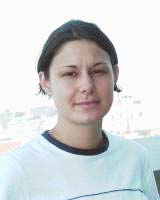 I flew here over the ocean from Serbia and Montenegro, where I finished my
undergraduate studies in astrophysics at the University of Belgrade. In
general, my astrophysical interest are broad, but my primary research
interests are in the area of radio astronomy, especially supernova
remnants and their evolution, starburst regions, structure and the state
of the ISM. Apparently, I am going to work on my first project under the
supervision of professor Ernie Seaquist. These days I am investigating the
city, trying to improve my english, and feeling a little bit nostalgic for
my family and friends. I enjoy swimming, walking through the fields, and
climbing the hills, especially with the man of my life, my husband Milos.
I'm an environmentalist and a vegetarian, and there are so many other things
that I like...
I flew here over the ocean from Serbia and Montenegro, where I finished my
undergraduate studies in astrophysics at the University of Belgrade. In
general, my astrophysical interest are broad, but my primary research
interests are in the area of radio astronomy, especially supernova
remnants and their evolution, starburst regions, structure and the state
of the ISM. Apparently, I am going to work on my first project under the
supervision of professor Ernie Seaquist. These days I am investigating the
city, trying to improve my english, and feeling a little bit nostalgic for
my family and friends. I enjoy swimming, walking through the fields, and
climbing the hills, especially with the man of my life, my husband Milos.
I'm an environmentalist and a vegetarian, and there are so many other things
that I like...
FERNANDO PENA
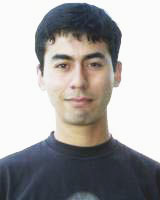 I was born in the beautiful city of Valdivia, 800 km south from Santiago,
Chile. Since the university in my hometown does not have an astronomy
program (lucky me, my country is a paradise for my passion, ASTRONOMY) I
went to Universidad Catolica in Santiago. There, I got my Licenciado en
Astronomia degree (similar to a bachelor). However, due to the
circumstances of life, I became deeply attracted to THEORETICAL
astrophysics. Therefore, my fifth year research project was about a new
type of object, now called "magnetar" (name invented from CITA's
present-day professor Chris Thompson). I am interested in almost all
physics areas, and their use in astronomy, but I am planning to take some
observational projects in my first year. Like many other Latinos, I LOVE
to play soccer, and dancing. The Andes Mountains also inspired me to ski
and climb. I also like music (classical, metal, 80's and musica latina),
movies, and taking pictures.
I was born in the beautiful city of Valdivia, 800 km south from Santiago,
Chile. Since the university in my hometown does not have an astronomy
program (lucky me, my country is a paradise for my passion, ASTRONOMY) I
went to Universidad Catolica in Santiago. There, I got my Licenciado en
Astronomia degree (similar to a bachelor). However, due to the
circumstances of life, I became deeply attracted to THEORETICAL
astrophysics. Therefore, my fifth year research project was about a new
type of object, now called "magnetar" (name invented from CITA's
present-day professor Chris Thompson). I am interested in almost all
physics areas, and their use in astronomy, but I am planning to take some
observational projects in my first year. Like many other Latinos, I LOVE
to play soccer, and dancing. The Andes Mountains also inspired me to ski
and climb. I also like music (classical, metal, 80's and musica latina),
movies, and taking pictures.
HILDING NEILSON
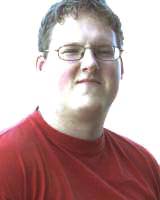 Hello, I am Hilding Neilson. I spent the past four years studying at St.
Mary's University in Halifax, Nova Scotia where I graduated with a degree
in astrophysics and math. Before that I grew up in a small town on the
west coast of Newfoundland called Pasadena. It is close to Gros Morne
National Park and living there I enjoyed the natural surroundings it
offered, through hiking and a little cross-country skiing. My previous
research interests lay in stellar structure and evolution, in particular I
found stellar convection to be a very interesting topic. My honours
thesis was devoted to creating a java applet so users could view pre-made
stellar models and their evolution. Although my primary research
interests are in stellar physics, I hope to expand my knowledge into other
branches of astronomy, as I am fascinated by all things numerical and
theoretical.
Hello, I am Hilding Neilson. I spent the past four years studying at St.
Mary's University in Halifax, Nova Scotia where I graduated with a degree
in astrophysics and math. Before that I grew up in a small town on the
west coast of Newfoundland called Pasadena. It is close to Gros Morne
National Park and living there I enjoyed the natural surroundings it
offered, through hiking and a little cross-country skiing. My previous
research interests lay in stellar structure and evolution, in particular I
found stellar convection to be a very interesting topic. My honours
thesis was devoted to creating a java applet so users could view pre-made
stellar models and their evolution. Although my primary research
interests are in stellar physics, I hope to expand my knowledge into other
branches of astronomy, as I am fascinated by all things numerical and
theoretical.
A new CCD at the DDO has been successfully started!
The new CCD system in the Cassegrain spectrograph of the DDO 1.88m telescope has had its first star light last night (Aug.18,'03 -ed). It is based on a 2000x800 pixel 15um, back-illuminated, thinned SITe chip in a system provided by Jobin-Yvon in PA. It has QE of about 80% in yellow and about 50% in blue i.e some 2x to 5x more sensitive than the old Photometrics chip. This will permit observation of objects some 1-2 magnitude fainter than now at the same S/N and with better resolution (the old system's pixels are 19 um). The system was purchased with grants provided by NSERC ($30k), with an additional substantial contribution ($15k) from the DAA.
I would like to thank the Technical Team of the DDO (Archie Ridder, Yakov Voronkov, Matt Rock) for exemplary work on the instrument, the work involving several mechanical changes to the spectrograph and electronic changes to the control system. I would particularly like to extend my special thanks Archie and Yakov for their dedication and hard work. Last but not least, the absolutely crucial role was played by the computer sciences student Peter Groszkowski. Peter, who came to us on recommendation of Charles Dyer, had a particularly difficult job of reverse-engineering the provided system (which came with inadequate documentation) and of writing all its software.
The new system will be used in the Cassegrain spectrograph while the old system will be moved to the echelle spectrograph.
The Helen Sawyer Hogg Telescope (HSHT, formerly located on Cerro Las Campanas in Chile) is now located in Argentina on Cerro Burek at the Observatorio El Leoncito. The 60-cm telescope is on permanent loan to the Argentine observatory. In return, the University of Toronto is entitled to a 25% share of the observing time. All expenses for reconstruction, operation and maintenance are paid by Argentina.
The telescope is now in operation, though it is not yet ready for remote observing. The problem is that the drive is not yet stable enough for long, unguided images. The plan is to operate the telescope remotely, first from the warm room of their 2.15m telescope (2 km line-of-sight distant, and 7 km by rough road), but ultimately from the DDO/DAA. Wouldn't it be nice to get images from the Southern Hemisphere?
The mountain is about 500 m higher than in Chile, the new building is about 4 m (a new floor) higher, and there are a dozen ventilator windows, just like the new generation of big monsters. This has a very positive effect on the size of the seeing disk. The average point spread function is 0.73 arcseconds, which is quite remarkable, but which also is the reason that the drive must be improved.
The telescope was used in August/September for its first scientific work in Argentina. Michael Snowden (Singapore) monitored Mars for 2 months.
Keep tuned for more news.
Two recent releases of recordings of classical music with interesting astronomical connexions.
1) Six symphonies by Sir William Herschel.
No 14, No 8, No 2, No 12, No 17, No 13
Those symphonies were composed when Herschel was still in his early
twenties. The recording claims to be *a world premiere* but I am pretty
sure that some of that material has been recorded before.
London Mozart Players, Matthias Bamert, cond.
On the Chandos Label (1CD) CHSA 5005
(confirms the impression that Herschel was a gifted, but, on the whole,
rather ordinary composer).
2) DIE HARMONIE DER WELT, by Paul Hindemith.
A 20th century German opera, based on the life of Kepler.
On the Wergo label (WER 6652), on 3CDs (in promotion, for the price of 2)
Also claimed to be a world premiere of the complete work - with the
emphasis put on the completeness, because I believe that there was an
incomplete recording in the LP era. Also, a symphony drawn from the score
has been recorded more than once, by the composer, among others.
I have never heard that work, but I very much want to, because it passes
for an experimental masterpiece of sorts. It tells of Kepler's search for
universal harmony in the chaotic world of the War of Thirty Years. In the
final scene, all of the characters reappear as planets or other astral
bodies, such as the Sun (the emperor), the moon (Kepler's mother), the
earth (Kepler himself), Jupiter (Wallenstein) etc. That may sound
ridiculous, but, in fact, it's supposed to be cleverly done, and leads to
meditation on the relationship between humanity and the visible universe.
The works dates back to the end of Hindemith's life, after his return to
Germany, which he had been forced to leave by the Nazis.
Pierre Marc Bellemare
pbellema@aix1.uottawa.ca
Added comment:
The symphonies are three-movement pieces, in the style of J. C. Bach. It is interesting to compare them with the work of young Mozart written at the same time. The difference between talent and transcendent genius is instantly audible...but you aren't absolutely certain why!
The CD is available from Amazon.
Lenny
DDO PICNIC
images by Sharon Lai (at CITA)
THE BLACKOUT OF 2003 FROM THE DDO
images by Ian Shelton
MILKY WAY SEEN OVER TORONTO FROM THE DDO
Thursday, August 14 @ ~10:00 pm EDT
(Sagitarius to Aquila,
around moonrise)
Thursday, August 14 @ ~10:30 pm EDT
(Summer Triangle at upper-left,
after moonrise)
VIEW TOWARDS DOWNTOWN TORONTO FROM THE DDO
Thursday, August 14 @ ~11 pm EDT
(power grid down)
Friday, August 15 @ ~11 pm EDT
(power grid back up)